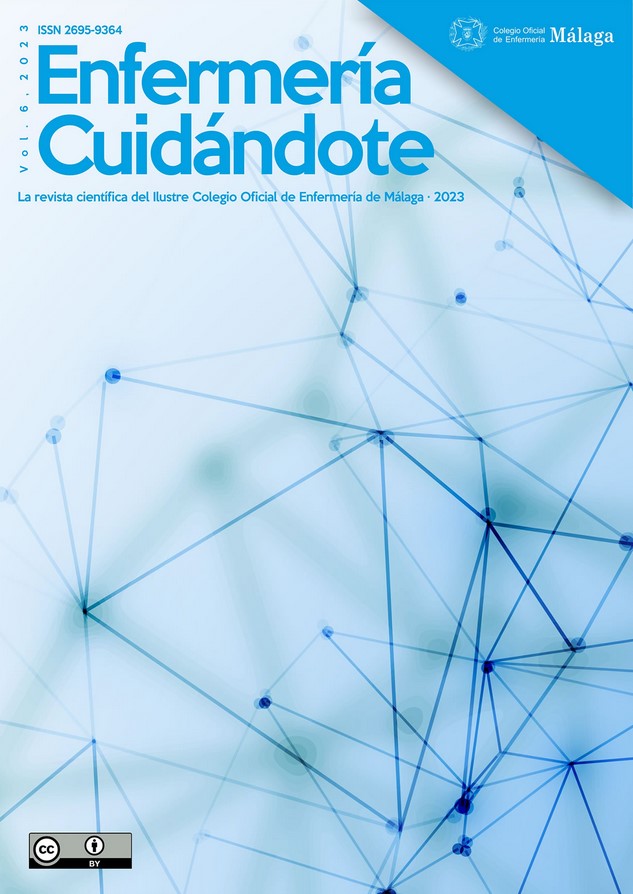Protective mechanics for successful extubation in invasive mechanical ventilation. Literature review
DOI:
https://doi.org/10.51326/ec.6.7299107Keywords:
Airway Extubation, Artificial Respiration, Complications, Primary PreventionAbstract
Objectives: to know the effectiveness of alternative measures to Conventional Oxygen Therapy (COT) that have been proposed for the prevention of post-extubation complications in adult patients admitted to the Intensive Care Unit (ICU) and connected to Invasive Mechanical Ventilation (IMV) in the first 72 hours.
Methods: Bibliographic searches were carried out in different search engines, highlighting PubMed and Cochrane. These searches were limited to clinical trials and systematic reviews published between 2016-2022. To assess the quality of the evidence, the CASPe and GRADE tools were used.
Results: The High Flow Nasal Cannula (HFNC) and Non Invasive Mechanical Ventilation (NIMV) present an effectiveness in the prevention of reintubation against COT of RR 0.54 (CI 95% 0.32–0.89) and RR 0.55 (95% CI 0.30 - 1.00) respectively. Regarding post-extubation acute respiratory failure, the values are RR 0.66 (95% CI 0.43 - 1.02) and RR 0.86 (95% CI 0.54 - 1.38), respectively.
Conclusion: HFNC and NIMV are significantly superior to COT in preventing reintubation, having both similar effectiveness. On the other hand, HFNC is shown to be slightly superior to NIMV in the prevention of post-extubation acute respiratory failure. However, more research is required in the ICU setting.
Downloads
References
Arellano Sepúlveda D. Ventilación Mecánica: Generalidades y Modalidades Tradicionales. Kinesiol. 2006; 25(4):17-25. Disponible en: https://enfermeria.medicina-intensiva.cl/docs/14.pdf [Consultado 07-03-2022]
Garnero AJ, Abbona H, Gordo-Vidal F, Hermosa-Gelbard C. Modos controlados por presión versus volumen en la ventilación mecánica invasiva. Med Intensiva. 2013;37(4):292-8. https://doi.org/10.1016/j.medin.2012.10.007
Pejerrey Villar GR. Frecuencia de lesiones laringotraqueales comunes ocasionadas post intubación prolongada en pacientes de la UCI del HRDLM, 2019. Lambayeque (Perú): Universidad Nacional Pedro Ruiz Gallo; 2020. Disponible en: http://repositorio.unprg.edu.pe/handle/20.500.12893/8577 [Consultado 06-03-2022]
Tocalini P, Vicente A, Carballo JM, Garegnani LI. Disfunción diafragmática asociada a la ventilación mecánica invasiva en pacientes adultos críticamente enfermos. Rev Fac Cien Med Univ Nac Cordoba. 2021;78(2):197-206. https://doi.org/10.31053%2F1853.0605.v78.n2.28458
Gómez de Oña J, Hoz García C, Utrilla Cid N, Cárdenas Cruz A. Análisis de las complicaciones que presentan los pacientes sometidos a un programa de ventilación mecánica invasiva. Actual Médica. 2020;105(811):153-9. https://doi.org/10.15568/am.2020.811.or01 [Consultado 06-03-2022]
Bosso M, Vega L, Bezzi M, Gogniat E, Rodrigues La Moglie R, Roux N, et al. Retirada de la vía aérea artificial: extubación en Terapia Intensiva. Revisión narrativa. Rev Argent Ter Intensiva. 2018;35(3):24-3. Disponible en: https://revista.sati.org.ar/index.php/MI/article/view/551 [Consultado 07-03-2022]
Díaz Díaz SC. Factores asociados al desarrollo de estridor laríngeo post-extubación y falla de la extubación en pacientes adultos hospitalizados en la Unidad de Cuidados Intensivos del Hospital Universitario Nacional de Colombia, Bogotá, año 2019. Bogotá: Universidad Nacional de Colombia; 2020. Disponible en: https://repositorio.unal.edu.co/handle/unal/79034 [Consultado 06-03-2022]
Zhu Y, Yin H, Zhang R, Wei J. High-flow nasal cannula oxygen therapy versus conventional oxygen therapy in patients with acute respiratory failure: a systematic review and meta-analysis of randomized controlled trials. BMC Pulm Med. 2017;17(1):201. https://doi.org/10.1186/s12890-017-0525-0
Zhu Y, Yin H, Zhang R, Ye X, Wei J. High-flow nasal cannula oxygen therapy versus conventional oxygen therapy in patients after planned extubation: a systematic review and meta-analysis. Crit Care. 2019;23(1):180. https://doi.org/10.1186/s13054-019-2465-y
Lee CC, Mankodi D, Shaharyar S, Ravindranathan S, Danckers M, Herscovici P, et al. High flow nasal cannula versus conventional oxygen therapy and non-invasive ventilation in adults with acute hypoxemic respiratory failure: A systematic review. Respir Med. 2016;121:100-8. https://doi.org/10.1016/j.rmed.2016.11.004
Hernández G, Vaquero C, González P, Subira C, Frutos-Vivar F, Rialp G, et al. Effect of Postextubation High-Flow Nasal Cannula vs Conventional Oxygen Therapy on Reintubation in Low-Risk Patients: A Randomized Clinical Trial. JAMA. 2016;315(13):1354-61. https://doi.org/10.1001/jama.2016.2711
Hernández G, Vaquero C, Colinas L, Cuena R, González P, Canabal A, et al. Effect of Postextubation High-Flow Nasal Cannula vs Noninvasive Ventilation on Reintubation and Postextubation Respiratory Failure in High-Risk Patients: A Randomized Clinical Trial. JAMA. 2016;316(15):1565-74. https://doi.org/10.1001/jama.2016.14194
Yasuda H, Okano H, Mayumi T, Narita C, Onodera Y, Nakane M, et al. Post-extubation oxygenation strategies in acute respiratory failure: a systematic review and network meta-analysis. Crit Care. 2021;25:135. https://doi.org/10.1186/s13054-021-03550-4
Raurell-Torredà M, Argilaga-Molero E, Colomer-Plana M, Ruiz-García T, Galvany-Ferrer A, González-Pujol A. Análisis comparativo de los conocimientos en ventilación mecánica no invasiva de profesionales de cuidados intensivos. Enferm Intensiva. 2015;26(2):46-53. https://doi.org/10.1016/j.enfi.2015.01.002
Cabello JB por CASPe. Plantilla para ayudarte a entender un Ensayo Clínico. En: CASPe. Guías CASPe de Lectura Crítica de la Literatura Médica. Alicante: CASPe; 2005. Cuaderno I. p.5-8. Disponible en: https://redcaspe.org/plantilla_ensayo_clinico_v1_0.pdf [Consultado 07-03-2022]
Cabello JB por CASPe. Plantilla para ayudarte a entender una Revisión Sistemática. En: CASPe. Guías CASPe de Lectura Crítica de la Literatura Médica. Alicante: CASPe; 2005. Cuaderno I. p.13-17. Disponible en: https://redcaspe.org/plantilla_revision.pdf [Consultado 07-03-2022]
Ministerio de Sanidad y Política Social. Unidad de cuidados intensivos. Estándares y recomendaciones. Madrid: Ministerio de Sanidad y Política Social; 2010. Disponible en: https://www.sanidad.gob.es/organizacion/sns/planCalidadSNS/docs/UCI.pdf [Consultado 15-05-2022]
Lewis SL, Hagler D, Bucher L, Heitkemper MM, Harding MM, Kwong J, et al. Guía práctica de enfermería médico-quirúrgica: evaluación y abordaje de problemas clínicos. 10th ed. Barcelona: Elsevier; 2018.
Vallejo de la Hoz G, Fernández Aedo I, Ballesteros Peña S. Manual práctico de enfermería de cuidados intensivos: guía rápida para estudiantes de enfermería en prácticas. Bilbao: Servicio Editorial de la Universidad del País Vasco; 2020.
Hospital General Universitario Gregorio Marañón. Medición de signos neurológicos (escala de Glasgow). 2nd ed. Madrid: Comunidad de Madrid; 2011. Disponible en: http://www.agapap.org/druagapap/system/files/EscalaGlasgow.pdf [Consultado 15-05-2022]
Lobos Bejarano JM, Brotons Cuixart C. Factores de riesgo cardiovascular y atención primaria: evaluación e intervención. Aten Primaria. 2011;43(12):668-77. https://doi.org/10.1016%2Fj.aprim.2011.10.002
Laborde M. Medida de la Saturación de Oxígeno por Medio Óptico. En: XIII Seminario de Ingeniería Biomédica Facultades de Medicina e Ingeniería Universidad de la República Oriental del Uruguay Montevideo; 2004. Disponible en: http://www.nib.fmed.edu.uy/laborde.pdf [Consultado 15-05-2022]
Imberger G, McIlroy D, Pace NL, Wetterslev J, Brok J, Møller AM. Positive end‐expiratory pressure (PEEP) during anaesthesia for the prevention of mortality and postoperative pulmonary complications. Cochrane Database of Syst Rev. 2010;9: CD007922. https://doi.org/10.1002/14651858.CD007922.pub2 [Consultado 15-05-2022]
Subirana M, Bazan P. Modalidades de ventilación mecánica. Enferm Intensiva. 2000;11(1):23-32. Disponible en: https://www.elsevier.es/es-revista-enfermeria-intensiva-142-articulo-modalidades-ventilacion-mecanica-13008814 [Consultado 15-05-2022]




















